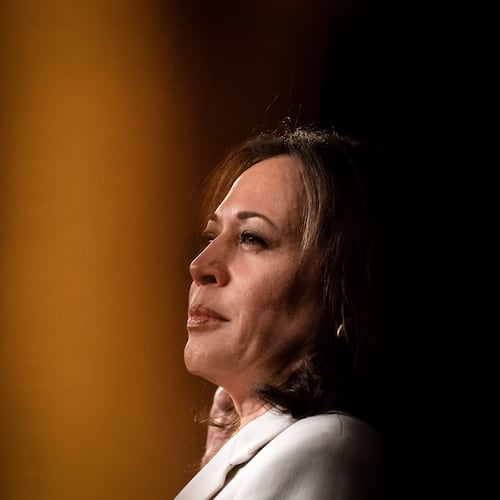Within the next few weeks, state Rep. Ron Stephens will likely begin a delicate debate over Georgia culture and history with this assertion: The Eugene Talmadge Memorial Bridge in Savannah isn't really the Eugene Talmadge Memorial Bridge.
It never has been.
Yes, the name of the segregationist governor has been physically attached to the graceful suspension bridge for 27 years now, but that was accomplished through bureaucratic fiat, Stephens’ research is expected to show.
Not by a proper act of the Legislature.
And because the bridge lacks an official name, his fellow lawmakers should feel free to bestow one chosen by the local community, Stephens will argue. The Republican prefers that the bridge bear the name of Juliette Gordon Low, a Savannah native and founder of the Girl Scouts.
“Savannah’s trying to become a progressive city. If we’re going to stamp a name on that bridge, figuratively and literally and legally, it ought to be her name,” Stephens said. “These prominent women — we just don’t name things after them.”
That this would allow a city that’s majority African-American and heavily dependent on tourism to escape the shadow of a prominent standard-bearer of Jim Crow — well, that’s neither here nor there.
“The last thing I want to do is disparage the name of the Talmadges in any way,” Stephens said. “The family is honorable. I appreciate what they did back in the ‘50s. There was nothing there — we didn’t have the paper mills, we didn’t have sugar mills.”
Stephens has good reason to speak nothing but good of the dead.
For the better part of six decades, the Talmadge name dominated Georgia politics. Eugene and Herman Talmadge, father and son, were both governors. "Gene" Talmadge, who died in 1946, specialized in racial appeals aimed at white rural Georgia. He was a fervent defender of the whites-only Democratic primary. Herman Talmadge began his political career as a segregationist, but ultimately made his peace with the civil rights movement. He died in 2002.
Each Talmadge has a portrait inside the state Capitol and a statue on the grounds outside. The painting of Herman Talmadge hangs just outside Stephens’ office.
The influence of father and son lingers. Former staffers for and supporters of Herman Talmadge are aging out, but can still be found in the building. (One of Herman Talmadge’s grandsons is a Capitol lobbyist – but wants no part of this bridge debate, thank you very much.)
Stephens has tried to remove the Talmadge name from the Savannah bridge before. His 2013 legislation came close to provoking fistfights. And this effort won’t be a cakewalk.
“There’s going to be members of the House — and Senate, possibly — that are married into the family somehow,” the Savannah lawmaker admitted.
But five years ago, the chairman of the House Economic Development and Tourism Committee didn’t know what he knows now.
The original Eugene Talmadge Memorial Bridge, connecting the city of Savannah to Hutchinson Island and thence to South Carolina, was a two-lane suspension affair.
The bridge was built in 1953. Herman Talmadge was governor at the time, which helps explain its name.
In 1991, the taller four-lane bridge replaced it. A measure to name the new structure after Eugene Talmadge passed the House, but didn’t clear the Senate, said Stephens. Nothing was offered up for Gov. Zell Miller’s signature. “We’re still doing our research, but that’s pretty clear,” he said.
Stephens suspects that the new bridge was christened through a resolution approved by the board that governs the state Department of Transportation.
“That changes everything. We think it opens up the door for us to officially name the bridge,” Stephens said. That’s “name.” Not “rename.”
The Chatham County legislative delegation is to gather next week to determine exactly which name to pursue. Last year, the Savannah city council endorsed simplicity: “The Savannah Bridge.” Another name under consideration belongs to U.S. Supreme Court Justice Clarence Thomas, another Savannah native.
As noted, Stephens prefers Juliette Gordon Low, who formed the first Girl Scout troops in Savannah in 1912. In her time (she died in 1927), Low would have been called a progressive on the topic of race.
Troops were usually all-white or all-black in the first decades of the group. But in the 1950s, ahead of many other youth organizations, Girl Scouts began a national desegregation effort, prompting Martin Luther King Jr. to endorse the organization as "a force for desegregation."
“The image we’re trying to show for Savannah clearly fits this amazing lady,” Stephens said.
To that end, Stephens said he intends to introduce his resolution to name – not rename – that suspension bridge in Savannah on Feb. 6.
On that particular Tuesday, thousands of Girl Scouts are scheduled to invade the Capitol. They will demand, politely, that lawmakers put the name of their founder on the no-name bridge that spans the Savannah River and leads to Juliette Gordon Low's birthplace.
My advice to the young ladies: Bring Thin Mints. Sleeves and sleeves of them.
About the Author
The Latest
Featured


